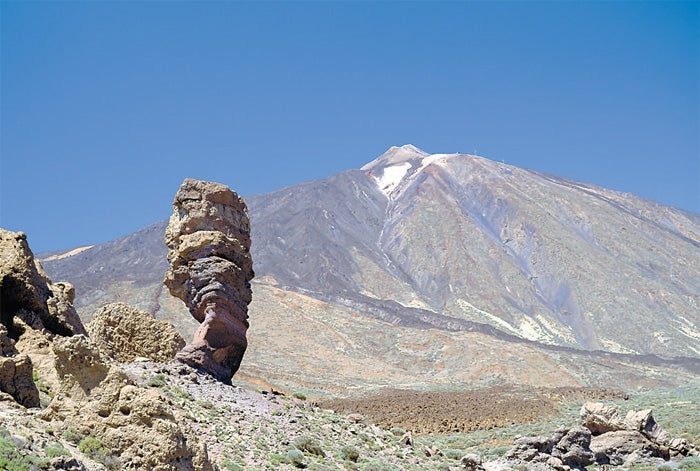It takes just eight minutes for the cable car to speed you to the top of Tenerife’s Mount Teide, the highest mountain on Spanish territory and the world’s third-loftiest volcano. Infinitely more rewarding, though, is to pull on your hiking boots, pack water and sunblock and devote five hours to walking up it. The path, called La Rambleta, starts almost apologetically from a lay-by at kilometre 40 on the road (the TR-21) that crosses the Teide National Park. At an altitude of 2,300m, you are already above the tree line, in the middle of a broad, ancient crater, rimmed by red and ochre walls of rock, out of which thrusts the severe and imposing cone of Teide.
If, like most visitors, you’ve travelled up from the coast, be prepared for the thinness of the air and, in the morning at least, a significant drop in temperature. From November until March the higher slopes are snow-covered, while in late autumn (when I did the walk) the first stretch along an undemanding zig-zagging 4x4 track was decorated with ice-covered bushes, which glinted and sparkled in the low sun. The flora of the volcano is sparse, either very hard-wearing like the retama (a species of broom) or very specialised, like the Teide violet, which has adapted to the harsh conditions by spending much of the year underground, emerging in spring to flower and reproduce.
Bird life is also scarce. I saw one kestrel during the climb, although barbary partridges and blue chaffinches are among the species to be seen in the national park.
The star of nature’s show is rock, in all shapes, sizes and colours. Most spectacular, about an hour into the walk, is a field of huge black balls of obsidian lava. Known as Los Huevos del Teide (the eggs of Teide), they look as though they’ve been rolled there during a giants’ bowling game.
Soon after, the 4x4 track gives way to a much steeper path that leads up to the mountain refuge of Altavista, where at 3,270m, a rest to catch your breath is very welcome. Stay here (booking is essential) and carry on the next morning to enjoy the ultimate moment of sunrise at the summit, with the preceding bonus of a night climb beneath a sky packed with stars.
The top station of the cable car gives you the opportunity to buy a drink, enjoy the sweeping views and indulge in smug feelings as you observe the trippers in their flip-flops and shorts, stumbling across the sharp rock of a lava flow and shivering in the keen wind. The other good thing about el teleférico is that, for the return leg of the journey, you could let the cable take the strain. (Although on very windy days the service is subject to interruptions or doesn’t run at all.)
The actual summit is a mere 200 metres higher, and reaching it from the top station takes less than an hour on a steep path. But beware, you need a permit for |this final stage (called El Teleforo Bravo) as access is strictly controlled. The rocks around the crater are yellow and white, hot |to the touch, while wisps of sulphurous steam escape from fumaroles, a reminder that this is a dormant volcano, which last erupted in 1909. Take time to appreciate the crowning glory of Teide: its views. On a clear day the other Canary Islands are visible; otherwise just enjoy the majestic sight of the celebrated “sea of clouds” and start to contemplate your return journey.
Getting there
A permit for the summit can be obtained from the national park office in Santa Cruz de Tenerife (Emilio Calzadilla 5; open 9am-2pm; take a copy of your passport). Or apply via e-mail teide@oapn.mma.es
One bus a day from Puerto de la Cruz (number 348) and Playa de la Americas (342) run to Teide. Both leave at 9.15am and return at 4pm.
Staying there
Refugio de Altavista, €20 a night. Bookings: 00 34 922 010 440 (includes permit for the summit). Parador de las Cañadas (00 34 922 374 841; parador.es) is the only hotel in the national park. Doubles from €135, excluding breakfast.

Join our commenting forum
Join thought-provoking conversations, follow other Independent readers and see their replies
Comments